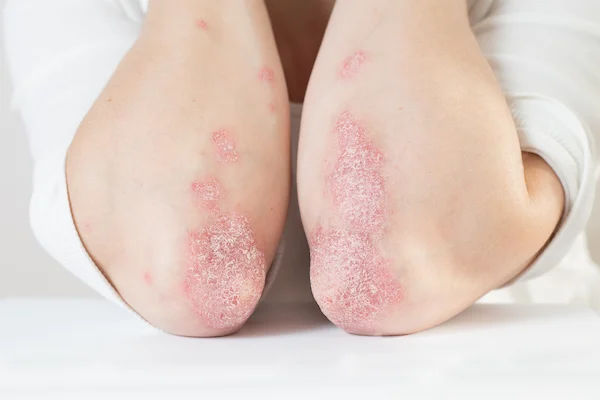Early Psoriasis
Learn about early-stage psoriasis, including its causes, initial symptoms, and effective management strategies to control flare-ups and maintain skin health.

Written by Dr Sonia Bhatt
Last updated on 3rd Jul, 2025
Psoriasis is a chronic autoimmune condition that accelerates skin cell production, leading to red, inflamed patches covered with silvery scales. It is marked by cycles of flare-ups and remission, varying in severity from mild to severe.
Early psoriasis refers to the initial stages, where symptoms are mild but can worsen if untreated. Recognising early signs allows for better management, reducing the risk of severe flare-ups. This article covers early psoriasis symptoms, causes, treatment options, and tips for effective management to improve outcomes and quality of life.
What Is Early Psoriasis?
Early psoriasis is typically the first phase of the disease, where symptoms may be subtle but still noticeable. As the skin's immune system becomes overstimulated, it speeds up the skin cell production process, which forms red, scaly patches that may cause discomfort, itching, or irritation. These early signs may appear as a few small, isolated patches, making it harder to distinguish from other skin conditions.
It’s important to understand that psoriasis is a lifelong condition, which means once symptoms appear, they tend to reoccur throughout a person's life, often flaring up during periods of stress or other triggering factors. Identifying early psoriasis allows patients to begin managing the condition before it progresses into more severe forms, such as plaque psoriasis or guttate psoriasis.
Common Early Psoriasis Symptoms
The symptoms of early psoriasis can vary between individuals, but there are a few common signs to look for:
1. Small, Scaly Patches
The most noticeable early psoriasis symptoms are the appearance of small, scaly patches of skin. These patches are typically red or pink in color with a silvery-white coating of dead skin cells, known as scales. They can appear anywhere on the body but are most commonly found on the elbows, knees, scalp, and lower back.
2. Itching or Burning Sensation
As the skin begins to develop patches, many people with early psoriasis report experiencing an itching or burning sensation in the affected areas. This discomfort can range from mild to intense, leading to further irritation and scratching.
3. Dry and Cracked Skin
In addition to the scaly patches, skin affected by early psoriasis can become dry, flaky, and even cracked. If left untreated, these cracks can become painful and may lead to bleeding or infection.
4. Inflamed or Swollen Skin
While the patches are typically red, they may also become inflamed, leading to swelling around the affected areas. This can make the patches appear larger or more noticeable and increase the discomfort.
5. Nail Changes
Some individuals may experience changes in their nails with early psoriasis. This can include small dents or pitting on the nails, along with thickening or separation of the nail from the nail bed.
6. Flare-ups After Certain Triggers
In some cases, early psoriasis may be triggered by certain environmental factors such as stress, skin injuries, infections, or cold weather. Identifying these triggers can be crucial for managing flare-ups and preventing more severe symptoms.
Consult Top Doctor For Psoriasis
What Causes Early Psoriasis?
While the exact cause of psoriasis remains unknown, a combination of various factors plays a role in developing early psoriasis.
1. Genetic Factors
Psoriasis tends to run in families, suggesting a genetic predisposition. If you have a family member with psoriasis, you may be at a higher risk of developing the condition. Specific genes that control the immune system, such as HLA-Cw6, have been linked to early psoriasis development.
2. Immune System Dysfunction
Psoriasis is an autoimmune disorder, meaning the immune system mistakenly attacks healthy skin cells. In the case of psoriasis, T-cells—a type of white blood cell—become overactive and attack the skin, leading to inflammation and the rapid production of new skin cells. This leads to the characteristic red or pink, scaly patches seen in early psoriasis.
3. Environmental Triggers
Environmental factors such as stress, infections, medications, and even weather changes can trigger the onset of early psoriasis. Certain triggers, like skin injuries or strep throat infections, may lead to the first appearance of psoriasis, or cause an existing case to flare up.
Risk Factors for Early Psoriasis
While anyone can develop psoriasis, certain risk factors make some individuals more likely to develop the condition:
Family history: If you have a close family member with psoriasis, you are at a higher risk of developing it.
Age: Psoriasis can occur at any age, but it most commonly begins between the ages of 15 and 35.
Immune system issues: People with compromised immune systems, such as those with HIV/AIDS or undergoing immunosuppressive treatments, are at an increased risk of developing psoriasis.
Infections: Certain infections, especially strep throat, are known to trigger early psoriasis in some individuals, particularly in children.
Stress: Emotional or physical stress is one of the most common triggers for psoriasis flare-ups, including the initial onset of symptoms.
How Is Early Psoriasis Diagnosed?
Diagnosing early psoriasis typically involves a physical examination by a dermatologist, who will assess the appearance of the skin, nails, and scalp. In many cases, a skin biopsy may be performed to confirm the diagnosis. During this procedure, a small sample of skin is removed and examined under a microscope for signs of psoriasis.
The dermatologist may ask about your family history, personal triggers, and any underlying medical conditions that could contribute to psoriasis's development. Early diagnosis is essential for effective management and preventing the condition from worsening.
Treatment Options for Early Psoriasis
Managing early psoriasis effectively involves a combination of treatments aimed at reducing symptoms, slowing skin cell turnover, and preventing flare-ups. Here are some specific treatment options:
1. Topical Treatments
Topical treatments are usually the first line of defence for early psoriasis. These treatments are applied directly to the affected areas of the skin. Common topical treatments include:
Topical Corticosteroids: These are the first-line treatment for mild psoriasis. They help reduce inflammation and relieve itching.
Vitamin D Analogues: These medications slow skin cell growth and reduce scaling.
Topical Retinoids: It helps reduce inflammation and is applied once or twice daily.
Calcineurin Inhibitors: These are used to reduce inflammation and plaque buildup, especially in sensitive areas.
2. Lifestyle Modifications
In addition to medical treatments, lifestyle changes can help manage early psoriasis:
Stress Management: Stress can trigger flare-ups, so practices like meditation, yoga, and mindfulness can be beneficial.
Healthy Diet: Eating a balanced diet rich in fruits, vegetables, and lean proteins can support overall skin health.
Avoiding Triggers: Identifying and avoiding triggers such as infections, skin injuries, and certain medications can help prevent flare-ups.
Living with Early Psoriasis: Tips for Better Management
While early psoriasis may seem overwhelming at first, with the right approach, you can manage the condition effectively. Here are some helpful tips for managing early psoriasis:
Consult a dermatologist early: If you notice any early signs of psoriasis, seek medical advice as soon as possible to start treatment.
Be consistent with your treatment plan: Stick to your prescribed treatment regimen to manage flare-ups and keep symptoms under control.
Monitor triggers: Keep track of what triggers your symptoms (stress, weather, infections) and take steps to avoid them.
Moisturise: Regularly use fragrance-free moisturisers to prevent dry skin and reduce irritation.
Conclusion
Recognising the early signs of psoriasis is key to preventing the condition from worsening. Early treatment can help reduce symptoms, manage flare-ups, and improve overall quality of life. If you notice any suspicious patches or changes in your skin, it’s important to consult a healthcare provider or dermatologist for a proper diagnosis and treatment plan.
Though early psoriasis may feel like a challenging condition to deal with, there are many ways to effectively manage it and prevent long-term complications to your health. With the right approach, you can continue to lead an active and healthy life.
Consult Top Dermatologist
Consult Top Doctor For Psoriasis
Dr. Mayuri Jain
Dermatologist
11 Years • MBBS, MD Dermatology , Venereology & Leprosy
Delhi
Dr Mayuri Jain Clinic, Delhi
Dr. Kavitha Killaparthy
Dermatologist
23 Years • MBBS,DIPLOMA(DERMATOLOGY,VENEREOLOGY,LEPROSY)
Hyderabad
JDS Skin & Hair Clinic, Hyderabad

Dr Ekansh Shekhar
Dermatologist
10 Years • MBBS MD
Lucknow
Apollo Clinic Hazratganj, Lucknow
Dr.j Girishma
Dermatologist
6 Years • MBBS MD DERMATOLOGY
Bengaluru
Apollo Medical Center, Marathahalli, Bengaluru

Dr. Madhab Datta
Dermatologist
5 Years • MBBS, MD (DVL)
Kolkata
Dr. Madhab Datta's Clinic, Kolkata
Consult Top Dermatologist
Dr. Mayuri Jain
Dermatologist
11 Years • MBBS, MD Dermatology , Venereology & Leprosy
Delhi
Dr Mayuri Jain Clinic, Delhi
Dr. Kavitha Killaparthy
Dermatologist
23 Years • MBBS,DIPLOMA(DERMATOLOGY,VENEREOLOGY,LEPROSY)
Hyderabad
JDS Skin & Hair Clinic, Hyderabad

Dr Ekansh Shekhar
Dermatologist
10 Years • MBBS MD
Lucknow
Apollo Clinic Hazratganj, Lucknow
Dr.j Girishma
Dermatologist
6 Years • MBBS MD DERMATOLOGY
Bengaluru
Apollo Medical Center, Marathahalli, Bengaluru

Dr. Madhab Datta
Dermatologist
5 Years • MBBS, MD (DVL)
Kolkata
Dr. Madhab Datta's Clinic, Kolkata

